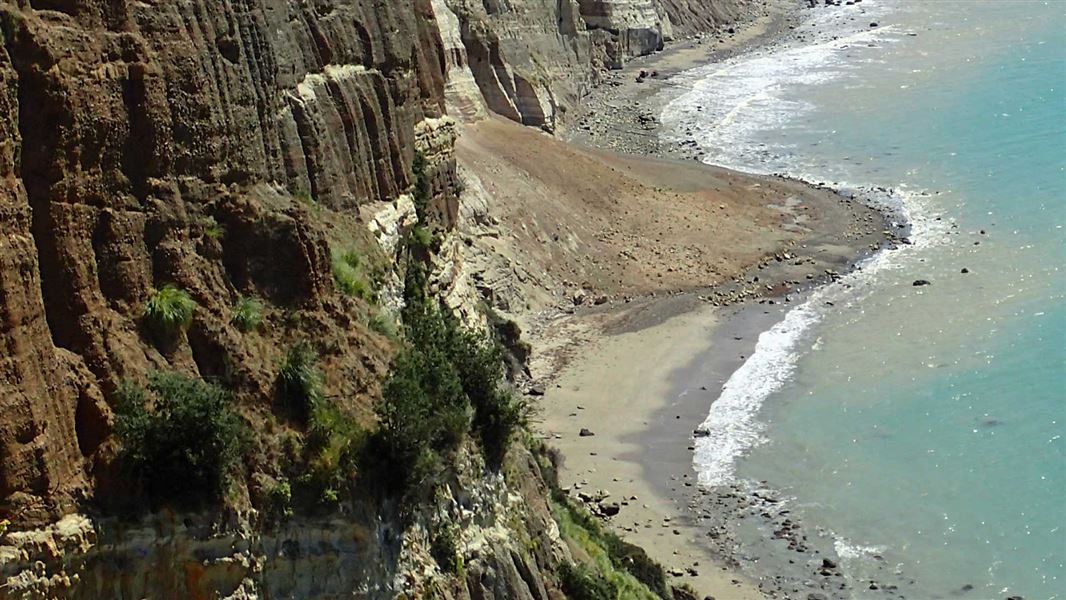19 km return via same track
This walk is along a beach and can only be attempted during low tide. Don’t get caught out by the tide – leave yourself enough time to return safely by checking the tide timetable.
The track from the beach to the plateau gannet colony is closed from July to the week before Labour Weekend each year, to limit disturbance to the returning birds. Labour Weekend dates.
Follow the beach from Clifton to Cape Kidnappers/Te Kauwae-a-Māui. This beach is subject to landslides and rockfall. The risk is real and significant and people who choose to travel down the beach are accepting this risk. The walk can only be attempted around low tide, and high tides and big seas will block the beach access.
Temporary orange barrier fencing is in place to manage steep drop offs caused by coastal erosion.
Black Reef is the first gannet nesting site, 7.5 km from Clifton. A 1 km climb takes you from the beach to a benched area on the hill where you can view the second colony. This access is steep and rough, and can be very muddy and slippery.
The track starts at Clifton, 21 km south of Napier and 18 km east of Hastings.
Local tourism operators can provide transport to/from the gannet colony if you don't want to walk there along the beach.
When to go
If undertaking the walk, the best time is between early November and late February. Nesting occurs between mid-September and mid-December. The first chicks hatch around the beginning of November and the last chicks migrate to Australia in May.
The track from the beach to the plateau gannet colony is closed from July to the week before Labour Weekend each year, to limit disturbance to the returning birds.
What to expect
- Change in elevation: +/- 100 m

Landslides and rockfalls
The geology of the cliffs at Cape Kidnappers influences the nature and frequency of landslides. The type of landslides at this beach can’t be predicted. Although there are some events that make them more likely to happen – such as earthquakes or rain – there is no obvious trigger for many of the landslides.
Serious landslides and rockfalls have injured people in the past. Do not attempt to climb the cliffs. Spend as little time as possible on the beach to reduce the risks, and do not stop or picnic here.
A significant landslide seriously injured two tourists in January 2019, and another large landslide occurred in February 2020 leading to closure of the beach.
If you are not comfortable taking on high risk adventures, this is not the trip for you. There is an alternative way of visiting the plateau gannet colony using an overland commercial operator.
Avoid high tides
This walk is along a beach and can only be attempted during low tide. Ensure you check the tide timetable and leave yourself enough time to return safely. It's best to:
- departing from Clifton to the Cape: leave at least 2 hours 30 minutes before low tide
- returning from the Cape to Clifton: leave the Cape no later than 1 hour 30 minutes after low tide.
Cape Kidnappers/Te Kauwae-a-Māui tide timetable
Occasionally, high tides and big seas block access along the beach.
Amenities
- The DOC track at the end of the beach is tramping standard.
Ensure you take:
- plenty of drinking water
- a water/windproof jacket, a hat and gloves, sunscreen and wear warm, layered clothing
- sturdy footwear such as tramping boots
- head torch
- communication device.
How to pack for a day walk
Stay safe in the outdoors
- Choose the right trip for you. Learn about the route and make sure you have the skills for it.
- Understand the weather. Check weather forecasts.
- Pack warm clothes and extra food. Check gear lists.
- Share your plans and take ways to get help. Share directly or use the Outdoor Intentions form or Plan My Walk. Take a distress beacon.
- Take care of yourself and each other.
DOC Customer Service Centre
| Phone: | 0800 275 362 |
| Email: | napier@doc.govt.nz |
| Address: | Ahuriri / Napier Office |
